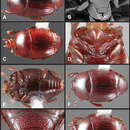Description
provided by Zookeys
Length: 1.40–1.78 mm, width: 1.09–1.31 mm; body rufescent, elongate oval, widest near humeri; frontal stria complete, subcarinate at middle; epistoma depressed at middle, apical margin appearing subcarinate; antennal club with basolateral pit, with second annulus interrupted on dorsal surface; lateral submarginal pronotal stria present in apical third to half; anterior submarginal stria barely recurved, much shorter than lateral submarginal; pronotal disk with ~15 coarser punctures, most concentrated in anterolateral third; antescutellar region broadly depressed, with narrow prescutellar impression barely longer than scutellum; outer subhumeral stria present in apical half only, inner subhumeral stria absent, striae 1-3 complete, 4th stria varied, from present in apical half to nearly complete, 5th stria present in apical half to two-thirds, sutural stria present in apical three-fourths; prosternal keel distinctly produced at base, with carinal striae closely-set, subparallel, weakly convergent to front, united in anterior arch about three-fourths from base; mesoventrite distinctly and discretely emarginate at middle, marginal stria complete; mesometaventral stria subangulate to midpoint of mesoventral disk, extending posterlaterally toward outer corner of metacoxa; 1st abdominal ventrite with two lateral striae complete, subparallel; propygidium with uniform round, shallow punctures separated by about their diameters; pygidium lacking apical marginal sulcus, ground punctation fine, dense, with coarser secondary punctures interspersed, denser along basal margin. Male genitalia (Fig. 43A–D, I): accessory sclerites present; T8 with sides weakly convergent apicad, with broad, shallow basal emargination, basal membrane attachment line about one-third distad basal emargination, apical emargination shallow, acute, with ventrolateral apodemes most well-developed basally, not meeting, narrowed to apex; S8 with sides moderately rounded in basal two-thirds, narrowing to apex, with apical guides narrow, not strongly upturned; S9 with sides subparallel in basal two-thirds, apices weakly convergent, bluntly acute at inner corners; T10 with halves separate; S9 rather short, narrowed at middle, expanded to broad, weakly emarginate base, with apical emargination narrow, apical flanges separate, desclerotized along midline; tegmen with sides weakly rounded, widest just distad midpoint, narrowed to subacute apex lacking subapical cleft, medioventral process well-sclerotized, acute, projecting beneath about one-fourth from base; median lobe about one-third tegmen length, proximal apodemes differentiated about two-thirds from gonopore; basal piece short, slightly less than one-fourth tegmen length.
- license
- cc-by-3.0
- copyright
- Michael S. Caterino, Alexey K. Tishechkin
- bibliographic citation
- Caterino M, Tishechkin A (2013) A systematic revision of Operclipygus Marseul (Coleoptera, Histeridae, Exosternini) ZooKeys 271: 1–401
- author
- Michael S. Caterino
- author
- Alexey K. Tishechkin

